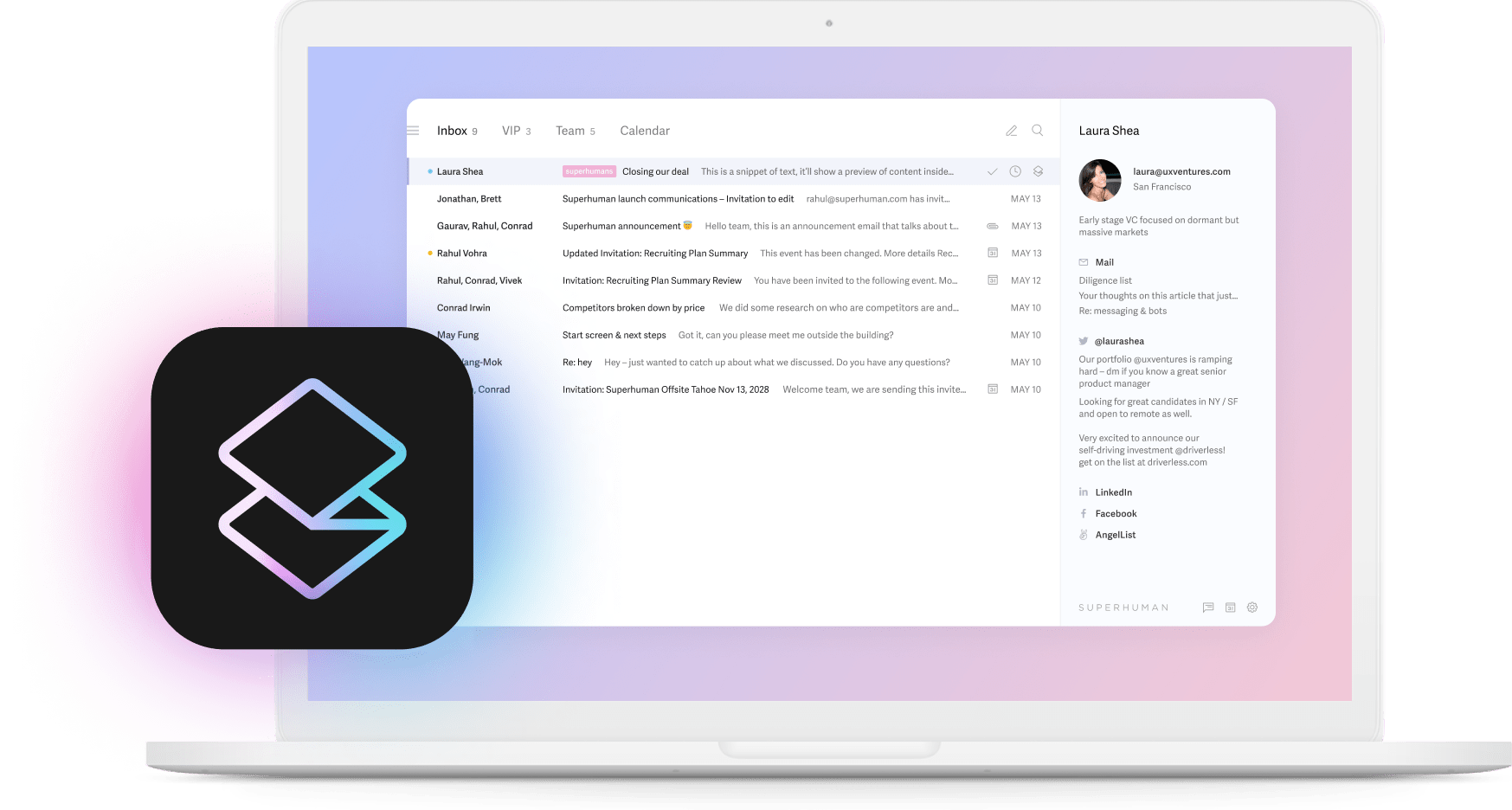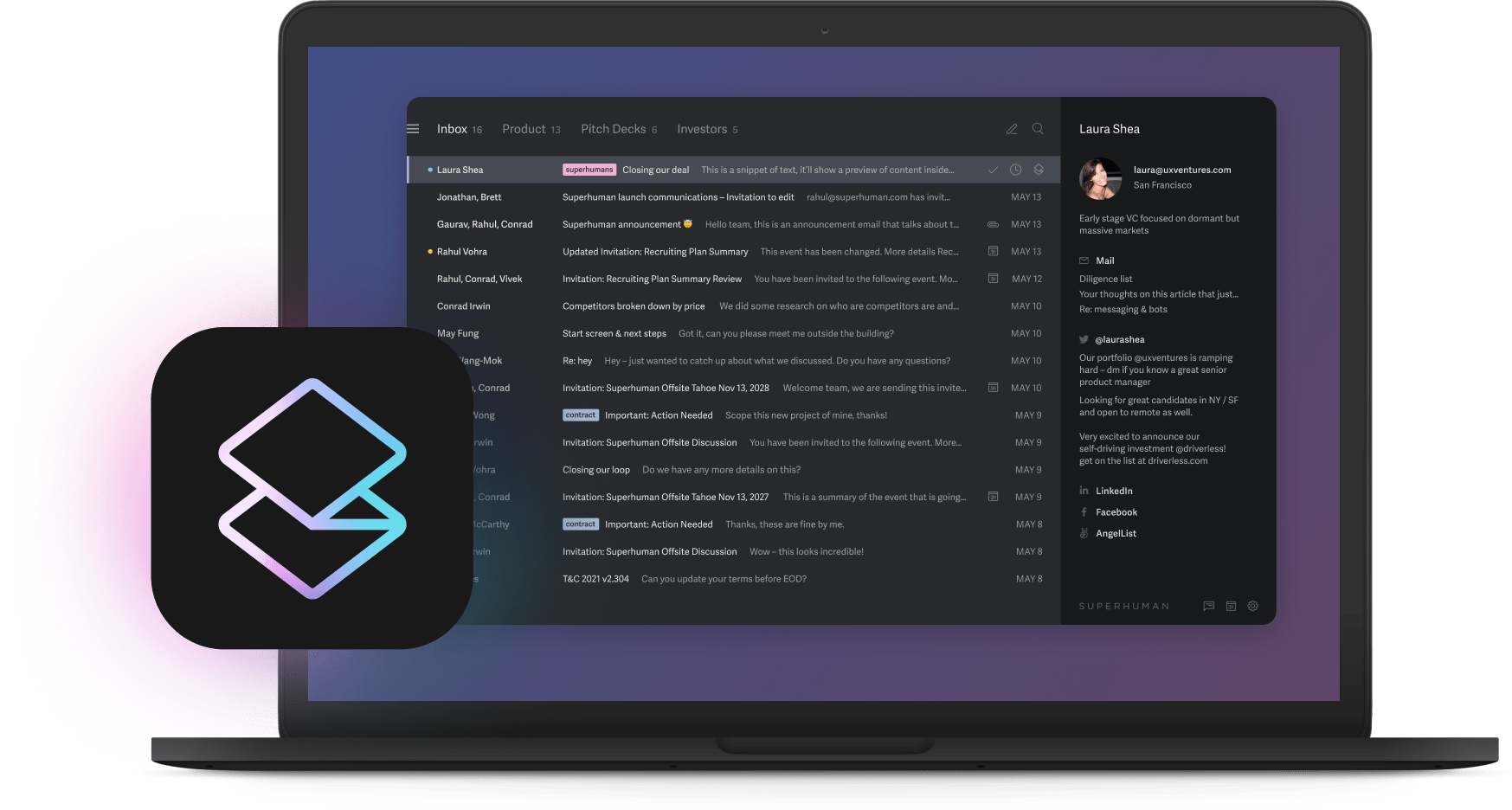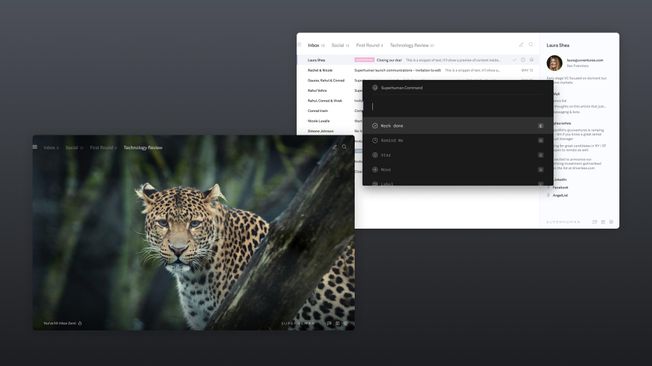
Updated with 2024-2025 market research, implementation frameworks, and decision guides.
Your finance team wastes three days every month consolidating reports from different systems. Your sales reps spend two hours daily updating CRM records instead of talking to prospects. Your support queue grows while agents copy and paste responses to routine questions. The right enterprise automation solutions can eliminate these bottlenecks entirely.
Here's what you need to know: companies using enterprise automation grow revenue 2.5x faster while teams save hours every week. This guide examines 20 leading solutions to help you choose the right approach for your organization.
The 20 best enterprise automation solutions at a glance
- Superhuman Mail - Overall best solution for AI-powered email productivity
- Reply.io - Sales outreach automation
- Moveworks - AI-powered IT support
- UiPath - Enterprise RPA platform
- Automation Anywhere - Cloud-native automation
- Blue Prism - Secure enterprise RPA
- Appian - Low-code process automation
- Pega - AI-powered decisioning
- IBM Automation - Enterprise workflow automation
- WorkFusion - Compliance-focused automation
- Celonis - Process mining and intelligence
- Microsoft Minit - Azure-integrated process mining
- Apromore - Open-source process analytics
- Kissflow - No-code workflow builder
- Pipefy - Visual workflow automation
- Coda - Connected docs with automation
- Nintex - Microsoft-integrated workflows
- Camunda - Developer-first process orchestration
- ABBYY - Intelligent document processing
- Kofax - Document capture and automation
Keep reading for a deeper understanding of this topic and full reviews of each of these 20 tools.
What is enterprise automation?
Enterprise automation is the organization-wide implementation of technology systems that execute business processes with minimal human intervention. Unlike task automation (scheduling social media posts) or process automation (invoice approval workflows), enterprise automation connects your CRM to your support system to your finance platform, enabling data to flow seamlessly while AI makes intelligent routing decisions at every step.
For fast-growing companies, this creates real advantages: teams respond to customers faster, revenue cycles accelerate, and operational costs drop while quality improves. Successful implementations achieve 5-10% EBIT impact according to McKinsey research.
The 20 best enterprise automation solutions reviewed
Communication and email automation
Email remains the backbone of business communication, but most tools were designed decades ago. AI-native platforms transform email from a productivity drain into a competitive advantage.
Enterprise workers using AI report 5.4% of work hours saved on average, translating to approximately 2.2 hours per 40-hour workweek. Advanced AI customers achieve 25.1% faster task completion with 40% higher quality output.
Superhuman Mail is the most productive email app ever made. Teams using Superhuman Mail save 4 hours per person every week, respond 12 hours faster, and handle twice as many emails in the same amount of time.
AI-powered productivity:
- Superhuman AI analyzes your previous messages and matches your tone automatically.
- Write with AI drafts complete emails from short prompts.
- Instant Reply generates contextual response options for every incoming message.
- Auto-Summarize condenses long threads into key points instantly.
Intelligent organization:
- Split Inbox automatically triages messages by importance, separating VIPs, team communications, and tool notifications.
- Auto Labels categorize incoming email without manual effort.
Never drop the ball:
- Reminders bring messages back at the right time.
- Send Later schedules emails for optimal timing.
- Read Statuses show exactly when recipients open your messages and on which device.
Team acceleration: Snippets let you save and share reusable templates with variables, tracking open and reply rates across your team. Team Read Statuses and reply collision detection keep everyone aligned without duplicate responses.
Speed features: Keyboard shortcuts help you fly through your inbox. Undo Send catches mistakes. Autocorrect fixes typos as you type, increasing typing speed by 30-50%. Social Insights surface LinkedIn, Twitter, and contact details for every sender.
Teams reply 1-2 days sooner, handle twice as many emails, and save 4 hours per person every single week. Built for Gmail and Outlook, Superhuman Mail makes email feel effortless again.
For teams focused on brand consistency across communications, Grammarly complements email automation by ensuring every message maintains consistent tone and style.
Quick win opportunity: Teams see immediate productivity gains without changing existing email workflows.
2. Reply.io
Focuses on sales email automation with multi-channel outreach capabilities. AI-native email warm-up improves deliverability while detailed analytics optimize campaign performance for revenue teams.
3. Moveworks
Automates IT service desk operations using natural language processing. Conversational AI handles employee support requests while connecting with enterprise tools like ServiceNow and Jira.
Enterprise automation platforms
Best for: Large companies with complex, multi-department processes requiring enterprise-grade security and scalability.
4. UiPath
Leads through ecosystem breadth and AI capabilities. The platform's document understanding processes contracts, invoices, and forms with high accuracy. Process mining finds automation opportunities automatically by analyzing how work actually flows through your company.
The marketplace contains thousands of pre-built automations for common business scenarios. Instead of building from scratch, teams can use proven solutions for expense processing, customer onboarding, or compliance reporting.
Quick win opportunity: Start with process mining to identify your highest-impact automation candidates before building any bots.
Focuses on cloud-native setup for rapid scaling. Teams build automations through browser interfaces without complex infrastructure setup. Bot Insight analytics show which automations deliver the most value, helping prioritize future development.
The platform's intelligent document processing handles unstructured data like emails, PDFs, and scanned documents. This capability proves crucial for companies processing vendor contracts, customer applications, or regulatory filings.
6. Blue Prism
Focuses on governance and security for regulated industries. Role-based access controls ensure only authorized personnel can modify critical automations. Complete audit trails track every action for compliance reporting.
7. Appian
Combines low-code development with process automation. Business teams can build custom applications without waiting for IT resources. The unified data fabric connects disparate systems, while mobile-responsive interfaces extend automation to field operations.
8. Pega
Specializes in customer engagement automation. AI-native decisioning engines personalize interactions in real time based on customer behavior, preferences, and history. The platform excels at managing complex customer journeys across multiple touchpoints.
Uses Watson AI for cognitive tasks requiring complex decision-making. Hybrid cloud setup accommodates diverse infrastructure requirements while enterprise connections work with existing IBM and third-party systems.
10. WorkFusion
Has compliance features essential for regulated industries. Machine learning algorithms continuously improve automation accuracy while digital workforce management handles complex scenarios across multiple systems.
Process intelligence and mining solutions
Best for: Companies that need to understand how work actually flows before automating anything.
11. Celonis
Serves over 1,000 global customers by turning process data into actionable insights. Real-time monitoring finds bottlenecks as they occur, while execution management provides immediate process improvements.
A manufacturing client discovered their order-to-cash process had 47 variations instead of the documented 3. Celonis found which variations created delays and automated the most efficient path.
ROI accelerator: Process mining often reveals quick wins that don't require new software, just process standardization.
12. Microsoft Minit
Connects seamlessly with Microsoft ecosystems through intuitive interfaces. Timeline analysis identifies process variations and bottlenecks while Power BI integration creates executive dashboards for monitoring process performance.
13. Apromore
Combines academic research with practical application. Advanced analytics include predictive modeling to forecast process outcomes. Simulation capabilities let you test process changes before putting them live, reducing risk and ensuring improvements deliver expected results.
Workflow and BPM automation
Best for: Teams that want to automate processes quickly without extensive technical resources or IT involvement.
14. Kissflow
Enables no-code workflow creation with over 50 pre-built applications. Teams get new workflows running in under 15 minutes using visual designers that require no programming knowledge.
A marketing team automated their campaign approval process, reducing approval time from 5 days to 30 minutes while creating automatic audit trails for compliance.
15. Pipefy
Uses Kanban-style process management with customizable pipelines. Real-time updates and notifications keep teams aligned while advanced reporting provides analytics for continuous improvement.
16. Coda
Combines the flexibility of documents with the structure of spreadsheets and the power of applications. Teams build custom workflows using tables, buttons, and automations without code. The platform integrates with tools like Slack, Jira, and Google Calendar, making it ideal for fast-moving teams that need collaborative docs and workflow automation in one place.
17. Nintex
Focuses on document-heavy workflows with e-signature connection. Extensive SharePoint and Office 365 connectivity enables seamless connection, while mobile capabilities support field operations.
18. Camunda
Provides developer-friendly BPM with REST APIs and microservices architecture. BPMN 2.0 standard compliance enables process modeling while supporting scalable setups for growing companies.
Document and data automation
Best for: Companies processing high volumes of unstructured documents like contracts, invoices, forms, or customer applications.
The intelligent document processing market reached $2.3 billion in 2024 and will hit $12.35 billion by 2030, representing 24.7% CAGR.
19. ABBYY
Achieves accuracy rates exceeding 99% across over 200 languages. AI-native content intelligence handles contract analysis and invoice processing automatically, extracting key terms and flagging exceptions for human review.
Real-world implementations show significant gains. Financial services organizations achieve 60% reduction in loan processing time with 12-month ROI. Healthcare providers achieve 70% increase in data processing speed for claims and medical records.
20. Kofax
Provides cognitive capture with machine learning-enhanced data extraction. Seamless RPA connection enables end-to-end automation while mobile capture supports field document processing.
How to choose the right enterprise automation solution
The 80/20 rule
Critical insight: Technology delivers only 20% of automation value. The remaining 80% comes from process redesign and organizational changes. Your budget should prioritize change management and workflow redesign over software purchasing alone.
The intelligent process automation market hit $14.55 billion in 2024 and will reach $44.74 billion by 2030, growing at 22.6% CAGR. Meanwhile, 88% of organizations now regularly use AI in at least one business function.
Where are you on the automation journey?
- Stage 1 (Point solutions): Solving specific pain points with individual tools. Quick wins but data silos.
- Stage 2 (Workflow integration): Connecting related processes across departments. Reduced friction between teams.
- Stage 3 (Intelligent orchestration): Systems making smart decisions based on data patterns. Processes adapt without human oversight.
- Stage 4 (Predictive automation): Systems anticipating needs and acting proactively.
Decision framework
Choose enterprise platforms (UiPath, Automation Anywhere, Blue Prism) when:
- You process thousands of transactions daily across multiple departments
- Compliance and audit trails are business-critical
- You need automation that scales with rapid growth
Choose workflow tools (Kissflow, Pipefy, Coda) when:
- Teams want to automate processes without IT involvement
- You need quick setup and immediate value
- Budget constraints favor subscription over large implementations
Choose specialized solutions when:
- Specific business functions create unique bottlenecks
- Deep expertise in one area beats platform breadth
- Connection requirements are straightforward
Implementation, costs, and governance
Five steps to implement
- Map your current processes. Document how work actually flows. Process mining can reveal the gap between documented procedures and reality.
- Set clear objectives. Define measurable outcomes before selecting technology. Specific goals like "reduce invoice processing time from 5 days to 4 hours" enable meaningful ROI tracking.
- Select the right tools. Match solutions to your specific requirements rather than chasing feature lists.
- Develop a phased plan. Start with high-impact, low-risk processes. Communication workflow optimization works well as an entry point because it affects every knowledge worker and delivers immediate productivity gains.
- Train your team and iterate. Invest in training that shows teams how automation helps rather than threatens their work.
Common mistakes to avoid
- Automating broken processes. If your current workflow has 47 variations when it should have 3, automation just makes a mess faster. Optimize first.
- Underestimating change management. Budget 3-5x more time for training and communication than you initially estimate.
- Ignoring data quality. Automation amplifies data problems. Clean your data foundations before building automation on top.
- Lacking clear ownership. Establish a center of excellence with defined responsibilities.
- Over-engineering initial implementations. Start simple. Expand scope only after proving value.
Hidden costs that derail budgets
- Governance programs: Center of excellence setup often costs 40-60% of initial platform licensing
- Exception handling: Even 95% automation accuracy means 5% of transactions require human intervention
- Bot maintenance: Plan for substantial annual maintenance costs for system changes and regulatory updates
- Training and change management: The critical 80% component
- Infrastructure and integration: Connection costs frequently double initial estimates
High-performing organizations that achieve 5-10%+ EBIT impact invest heavily in the organizational component, not just technology.
Timeline expectations
45% of organizations expect near-term ROI (under 3 years) from basic automation. 60% expect longer timelines for advanced AI automation.
Governance essentials
- Automation center of excellence: Dedicated team for standards and best practices
- Bot lifecycle management: Defined phases for development, testing, deployment, monitoring, and retirement
- Audit and compliance: SOX requirements, regulatory audit trails, security protocols
- Performance monitoring: Real-time tracking, exception handling, success metrics
Organizations with mature governance achieve 50% reduction in effort and 40% reduction in costs.
Building competitive advantage through intelligent automation
The companies putting enterprise automation solutions to work today are building tomorrow's competitive advantages. Speed, accuracy, and responsiveness become differentiators when automation eliminates operational friction.
The critical insight remains constant: technology delivers only 20% of the value. The remaining 80% comes from organizational transformation: process redesign, change management, governance frameworks, and cultural adaptation.
Start where every knowledge worker spends the most time: email. Communication workflows affect every employee and deliver immediate, measurable productivity gains. Teams using AI-powered email automation save hours weekly while responding faster to customers, colleagues, and opportunities.
Get started with Superhuman Mail, the fastest way to see enterprise automation in action.





